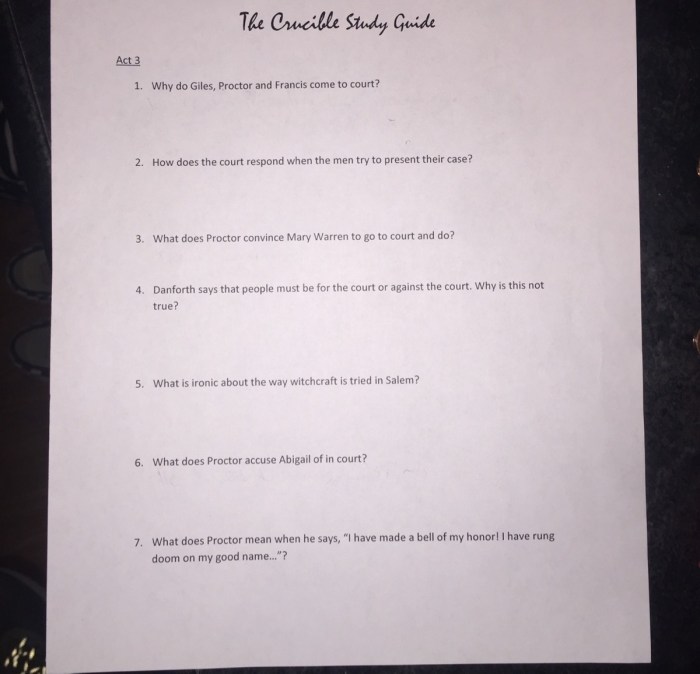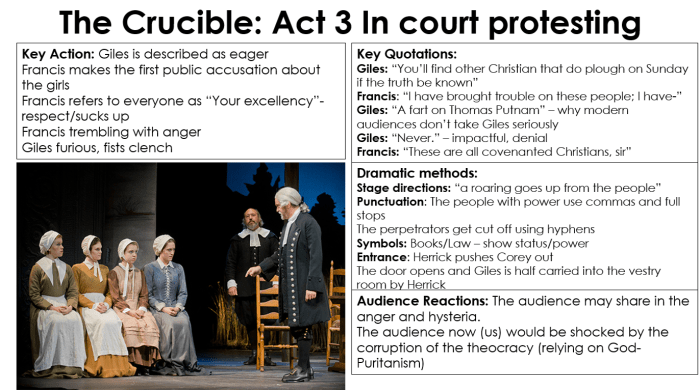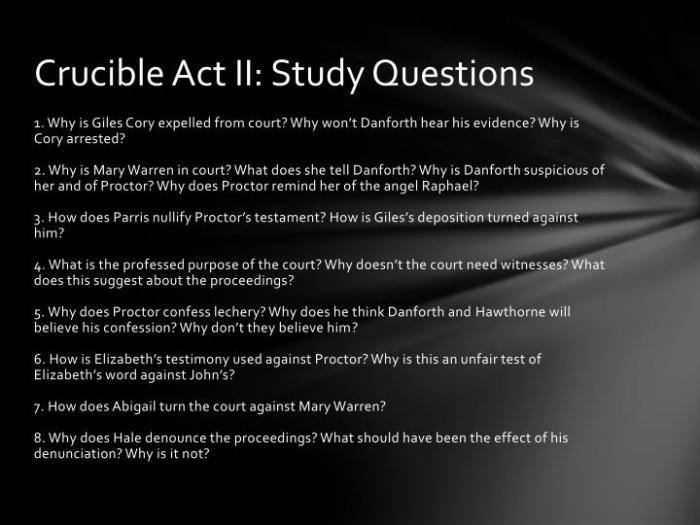Act 1 crucible study guide – Welcome to Act 1 of The Crucible, a captivating study guide that transports you to the heart of the infamous Salem witch hunts. This guide provides an immersive exploration of the play’s historical context, key characters, and the chilling events that unfold.
As the curtain rises on Act 1, we are introduced to a community gripped by fear and superstition. The accusations of witchcraft begin, tearing apart relationships and threatening to consume the entire town. Join us as we delve into the motivations, conflicts, and consequences that shape this pivotal act.
The Crucible: Act 1 Crucible Study Guide

Act 1 Setting and Characters, Act 1 crucible study guide
The Crucible is set in Salem, Massachusetts, in 1692, during the infamous witch trials. The play depicts the mass hysteria and paranoia that gripped the community, leading to the unjust accusations and executions of innocent people.
Historical Context
The Salem witch trials were a dark period in American history, characterized by religious intolerance, superstition, and a thirst for vengeance. The Puritans who settled Salem believed that the devil was constantly tempting them to sin, and they were quick to suspect anyone who seemed different or who did not conform to their strict moral code.
Setting
The play takes place in the homes of several families in Salem, as well as in the town meeting house and the courthouse. The setting is both physical and psychological, as the characters are trapped in a world of fear and suspicion.
Characters
The main characters in The Crucible include:
- Abigail Williams: A young woman who accuses several innocent people of witchcraft in order to get revenge on them.
- John Proctor: A farmer and former town official who tries to stand up to the witch hunt but is eventually arrested and executed.
- Elizabeth Proctor: John’s wife, who is also accused of witchcraft and executed.
- Reverend Samuel Parris: The minister of Salem who is quick to believe the accusations of witchcraft.
- Deputy Governor Danforth: The judge who presides over the trials and is determined to find the witches.
The characters in The Crucible are complex and flawed, and they are all caught up in the madness of the witch hunt. The play explores the themes of mass hysteria, guilt, and the dangers of unchecked power.
The Salem Witch Hunts
The Salem witch hunts, which occurred in the late 17th century in the Massachusetts Bay Colony, were a dark chapter in American history. The events that unfolded in Salem serve as a chilling reminder of the dangers of mass hysteria, religious extremism, and the erosion of individual rights.
The witch hunts were sparked by a combination of factors, including religious tensions, economic instability, and a heightened fear of the unknown. The Puritan society of Salem was deeply religious, and the belief in witchcraft was widespread. Additionally, the colony was experiencing economic hardship, which created an atmosphere of anxiety and suspicion.
The Outbreak of Hysteria
In 1692, a group of young girls in Salem began exhibiting strange symptoms, such as fits, convulsions, and hallucinations. These symptoms were attributed to witchcraft, and the girls accused several women in the community of being witches. The accusations spread like wildfire, and soon dozens of people were arrested and charged with witchcraft.
The trials that followed were a mockery of justice. The accused were often denied basic legal rights, and the evidence against them was often flimsy. Many of the accused were convicted and executed, including innocent people who were simply victims of mass hysteria.
Parallels to The Crucible
The events of the Salem witch hunts bear striking parallels to the events depicted in Arthur Miller’s play, “The Crucible.” In both cases, a community is gripped by mass hysteria and suspicion, and innocent people are unjustly accused and punished.
Miller’s play serves as a powerful reminder of the dangers of allowing fear and prejudice to override reason and justice.
The Accusations Begin
The accusations in The Crucible are initiated by Abigail Williams, a young woman who is in love with John Proctor. Abigail is motivated by her desire to get rid of Proctor’s wife, Elizabeth, so that she can have him for herself.
She also uses the accusations as a way to gain power and control over the community.
The accusations are initially met with disbelief and skepticism by the community. However, as more and more people are accused, fear and superstition begin to take hold. People start to believe that the devil is at work in Salem, and that anyone could be a witch.
This leads to a climate of hysteria and paranoia, in which innocent people are accused and condemned without trial.
The Role of Fear and Superstition
Fear and superstition play a major role in fueling the accusations in The Crucible. The people of Salem are afraid of the unknown, and they are quick to believe that the devil is at work in their community. This fear leads them to make accusations against innocent people, even those they know and trust.
Superstition also plays a role in the accusations. The people of Salem believe in a number of superstitions, such as the belief that witches can fly and that they can cast spells. These beliefs make it easier for people to believe that the accused are guilty, even when there is no evidence to support the charges.
The Examination of Abigail and the Accused

Abigail’s examination by Reverend Parris marked a turning point in the Salem witch trials. The examination of the accused that followed revealed the growing fear and hysteria that gripped the community.
Examination of Abigail
Abigail, initially hesitant, confessed to dancing in the forest with other girls and conjuring spirits. However, she accused Tituba, the slave, of being the instigator. Parris’s biased questioning led him to believe Abigail’s claims, despite her previous lies and inconsistencies.
Examination of the Accused
The examination of the accused became a spectacle. Accusers, including Abigail and the other girls, testified against them. The evidence presented was often flimsy, consisting of spectral evidence (visions) and rumors. Accused individuals were often denied the opportunity to defend themselves, and their reputations were tarnished.
Motives and Biases
The accusers’ motives were complex. Some were driven by personal grudges, while others sought attention or power. The accused, on the other hand, were often outsiders or those who challenged the established order. The trials became a way to silence dissent and enforce social conformity.
To ace your Act 1 Crucible study guide, it’s crucial to have a solid understanding of the characters and their motivations. This will help you grasp the play’s central themes and conflicts. For further insights into the legal aspects of the Salem witch trials, you can also refer to the Unit 5 Exam: Joshua’s Law for an in-depth analysis of the legal framework surrounding the trials.
Returning to the Act 1 Crucible study guide, pay special attention to the role of Abigail Williams and her influence on the unfolding events.
The Conflict between Proctor and Parris

The conflict between John Proctor and Reverend Parris stems from a combination of personal grievances and differing ideologies.
Proctor, a prosperous farmer and respected member of the community, holds contempt for Parris’s greedy and self-serving nature. He believes that Parris exploits his position to accumulate wealth and power, and that his sermons are devoid of genuine spirituality.
Parris, on the other hand, views Proctor as a threat to his authority. He is aware of Proctor’s skepticism towards the church and his support for Reverend Hale, a more liberal and tolerant minister. Parris fears that Proctor’s influence could undermine his position in the community.
Accusations and Arguments
The conflict between Proctor and Parris intensifies when Abigail Williams, Parris’s niece, accuses Proctor’s wife, Elizabeth, of witchcraft. Proctor vehemently denies the accusation and accuses Abigail of lying. This accusation triggers a series of events that lead to the Salem witch trials.
Proctor argues that Abigail is motivated by revenge, as he had previously dismissed her advances. He also points to the fact that Abigail and her friends were caught dancing in the woods, which was considered a sign of witchcraft. Parris, however, insists that Abigail is telling the truth and that Proctor is trying to protect his wife.
Implications for the Community
The conflict between Proctor and Parris has a profound impact on the community of Salem. It divides the town into factions, with some supporting Proctor and others supporting Parris. The accusations of witchcraft create an atmosphere of fear and suspicion, and the trials become a means of settling personal grudges and eliminating political rivals.
The conflict between Proctor and Parris ultimately leads to the downfall of both men. Proctor is executed for witchcraft, and Parris is driven out of town. The Salem witch trials serve as a cautionary tale about the dangers of mass hysteria, intolerance, and the abuse of power.
The Imprisonment of Elizabeth Proctor
Elizabeth Proctor’s arrest and imprisonment serve as a pivotal moment in the play, escalating the conflict and exposing the play’s central themes.
John Proctor’s Reaction
John Proctor is devastated by Elizabeth’s imprisonment. He knows that she is innocent and that her arrest is a miscarriage of justice. He is furious with the authorities and determined to clear her name.
The Community’s Reaction
The community is divided in its reaction to Elizabeth’s imprisonment. Some people believe that she is guilty, while others believe that she is innocent. The division within the community reflects the larger conflict between good and evil that is at the heart of the play.
Significance for the Play’s Themes
Elizabeth’s imprisonment highlights the play’s themes of justice, truth, and the dangers of mass hysteria. Her arrest shows how easily justice can be perverted when people are driven by fear and superstition. It also shows how the truth can be difficult to find in a time of mass hysteria.
Expert Answers
What is the significance of the setting in Act 1 of The Crucible?
The setting of Salem, Massachusetts in 1692 plays a crucial role in shaping the events of the play. The Puritan community’s strict religious beliefs and fear of the unknown create a fertile ground for the outbreak of witchcraft accusations.
How does Abigail Williams initiate the accusations?
Abigail Williams, driven by jealousy and a desire for revenge, accuses Tituba, a slave, of witchcraft. Her accusations quickly spread, leading to the arrest and imprisonment of several innocent people.
What is the conflict between John Proctor and Reverend Parris?
John Proctor and Reverend Parris clash due to their differing views on the accusations. Proctor believes the accusations are false and motivated by personal grudges, while Parris is determined to root out any suspected witches.